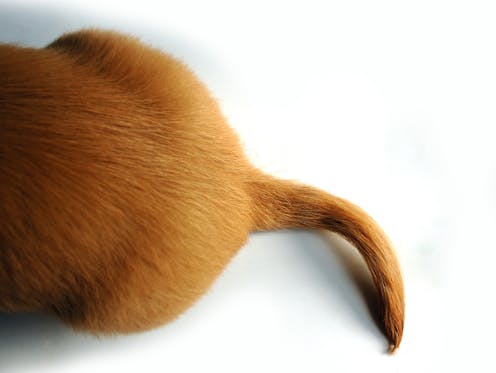Why do animals have tails?
- Written by Michael A. Little, Professor Emeritus of Anthropology, Binghamton University, State University of New York

A communication aide
Birds use their feathered tails both to balance while sitting on a tree limb and to steer and reduce drag while flying[20]. Some birds also use their tail as a mating display.
This visual display is most remarkable in species such as turkeys[21] and peacocks[22]: Male turkeys and peacocks will unfurl their colorful tail feathers to attract female mates.
Animals that live and hunt in groups or packs, like wolves, use a variety of tail positions[23] to indicate their rank.
Dogs, who descended from wolves, also use their tails for communication[24]. You’ve probably seen dogs wag their tails when they’re excited[25].
Why you don’t have one
Even though humans don’t have a long grasping tail like monkeys do, or a vibrant feather tail like peacocks have, our ancestors did have tails[26].
Scientists believe those tails vanished from our human ancestors around 20 million years ago[27]. Once they started walking upright, they no longer needed tails[28] to help with balance anymore.
Hello, curious kids! Do you have a question you’d like an expert to answer? Ask an adult to send your question to CuriousKidsUS@theconversation.com[29]. Please tell us your name, age and the city where you live.
And since curiosity has no age limit – adults, let us know what you’re wondering, too. We won’t be able to answer every question, but we will do our best.
References
- ^ Curious Kids (theconversation.com)
- ^ curiouskidsus@theconversation.com (theconversation.com)
- ^ found fossils of animals with tails (penntoday.upenn.edu)
- ^ fanlike tails (doi.org)
- ^ swim through oceans (www.nytimes.com)
- ^ these fish evolved (evolution.berkeley.edu)
- ^ tails side to side to balance (doi.org)
- ^ kangaroo’s tail (doi.org)
- ^ help them balance (doi.org)
- ^ tail for balance (doi.org)
- ^ while swinging through forest tree branches (doi.org)
- ^ prehensile, or grasping, tails (doi.org)
- ^ hold the animal up while it eats (doi.org)
- ^ stinger tail (doi.org)
- ^ shake it (doi.org)
- ^ their tails can do both (www.pnas.org)
- ^ waived as a whisk (doi.org)
- ^ that kind of tail (doi.org)
- ^ Paul Starosta/Stone via Getty Images (media.gettyimages.com)
- ^ while flying (doi.org)
- ^ species such as turkeys (www.youtube.com)
- ^ peacocks (doi.org)
- ^ tail positions (wolf.org)
- ^ tails for communication (doi.org)
- ^ when they’re excited (vcahospitals.com)
- ^ our ancestors did have tails (www.vox.com)
- ^ 20 million years ago (www.nytimes.com)
- ^ no longer needed tails (pursuit.unimelb.edu.au)
- ^ CuriousKidsUS@theconversation.com (theconversation.com)
Authors: Michael A. Little, Professor Emeritus of Anthropology, Binghamton University, State University of New York
Read more https://theconversation.com/why-do-animals-have-tails-187575

